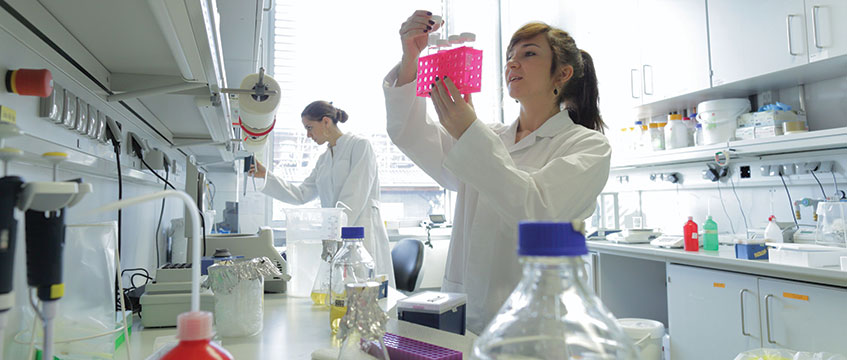The UK is a major player in the global life sciences market. Predominantly driven by Cambridge and Oxford, the UK scorecard for the life sciences sector shows that it contributes approximately £74bn to the country’s economy, with several billion more spent on R&D every year.
While Cambridge and Oxford dominate the industry, there are hubs elsewhere, plus the need for others to grow swiftly in order to meet industry demand. Overall, it’s clear that the amount of available laboratory and R&D space in our cities is small compared to other global cities. Currently, London has just 87,000 sq ft and Manchester 360,000 sq ft of available space. This is compared with Boston and New York which have 14.6m sq ft and 1.36m sq ft available respectively.
As the vanguard in the sector, lessons can be learned from Cambridge. The home of the UK’s first science park back in 1970 and its proximity to one of the world’s leading universities enabled the city to seize the crown as the UK’s foremost life sciences hub. It may have had first-mover advantage, but the city’s continued success is partly attributable to its key strength in defining clusters of life sciences activity in order to continue to attract companies; a success that other places should look to mimic.
Occupiers in the life sciences sector thrive best being part of a wider ecosystem of talent creation and innovation. Similar like-minded and complementary companies want to be located in the same area, to take advantage of shared knowledge and business synergies, or to be near to knowledge gateways. This can be a significant barrier to towns and cities that want to foster a life sciences hub and landlords attracting tenants, particularly if they only have a single building in an area. However, for those that own a number of commercial buildings in a single area, there could be opportunities to accelerate the process to create new science or tech clusters. To do so will need strong leadership, an exciting vision, the curation of the right tenants and a long-term strategic commitment to deliver a series of new lab spaces, as and when existing leases expire.
Cambridge’s momentum will be maintained, boosted by its fundamental role in the government-backed Oxford-Cambridge arc, but it is set to share more of the limelight. The recent planning approval for Oxford North will deliver a quantum and quality of stock that Cambridge will not be able to match in the short-term, but all the 26 district and unitary authorities and five Local Enterprise Partnerships covered by the arc, including towns and cities such as Milton Keynes, Northampton, Bedford, Luton and Aylesbury, are set to benefit.
As such, Oxford is garnering global attention from a number of firms, particularly in the US, which are beginning to realise the potential of this emerging market. As the clusters continue to grow and hone their offers, we are likely to see demand from companies based on the east and west coasts of America that are looking for an ideal springboard into Europe. These businesses will be able to capitalise on the comparably cheaper rents and living costs to similar clusters in locations such as Boston. There is no doubt that this has already started: in 2016 just 8% of Oxford’s take-up could be attributed to the life science and tech sectors. Fast-forward to 2017 and not only did transactions double, but this figure jumped as high as 80% and has remained constant to this day.
While the Oxford-Cambridge arc has the potential to deliver 9.6m sq ft of office and R&D floor space to the region, it shouldn’t overshadow exciting progress being made elsewhere. There are various cluster of life sciences in the north-east of England, for instance. In Newcastle, which has a target of delivering 14,000 new jobs by 2030, the Helix development will be home to international business and academia, including the business school and start-ups, featuring lab, research and engineering space. Later-stage venture capital is occurring in the city region, which is a good sign for expanding companies.
The capital also continues to be a key focus. London is clearly a major life sciences cluster in the UK, but it does suffer from a shortage of appropriate science-related workspace, particularly laboratories, to accommodate the growing company demand as a result of capital being raised and headcount growth increasing. Even with the challenges involved, key areas are now growing, specifically those in King’s Cross at the British Library site and in Sutton, south London, where there are plans to create a London cancer hub. These clusters bear parallels with Cambridge: springing up around world-renowned institutions such as Imperial College London and the Francis Crick Institute to maximise collaboration and recruit the best people.
With institutional investors and landlords looking towards the life sciences as a way to fill empty commercial space, other locations are likely to come onto the radar in the next few years. Providing the perfect lab environment isn’t easy though: repurposing existing buildings starts with the fabric, which may need to be upgraded to improve the transference of heat into the laboratories, and extra ventilation and plants are likely to be essentials. Embarking on plans to create a life sciences hub is therefore not something to be embarked on lightly, whether by a landlord or a city, but given the rate at which the sector is growing and the opportunities available, it’s certainly something that we’re going to see a lot more of.
Steve Lang is a director in the Savills commercial research team











